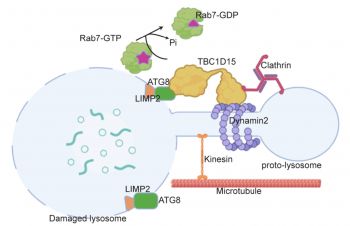06 Apr 2023 - How to regenerate acutely damaged lysosomes?
Lysosomes are small membranous organelles which are essential for recycling cellular waste. They are critical to cellular health and lysosomal dysfunction is a predominant feature of several diseases like lysosomal storage disorders, neurodegeneration and nephropathies. The absence of functional lysosomes leads to a build-up of toxic cellular waste which is detrimental to all aspects of cellular metabolism and function.
A team of researchers around IBC2 Director Ivan Đikić studied the neighbourhood of damaged lysosomes by unbiased proteomics and high-resolution microscopy and stumbled onto a previously unknown regeneration pathway which can restore lysosomal function following acute membrane damage. As published now in Nature Cell Biology, this pathway is activated within the first 2 hours of damage and requires the concerted action of a group of proteins including TBC1D15, Dynamin2, clathrin and molecular motors. The autophagy machinery, including ATG8 proteins, is also an indispensable part of this molecular ensemble, which is needed to regenerate functional lysosomes following membrane damage. Upon damage, LIMP2, a lysosomal membrane protein, binds ATG8 proteins and recruits TBC1D15, which in turn recruits the regeneration machinery. Live cell imaging of lysosomes in cells treated with the lysosomotropic drug LLOMe captured the regeneration process in real time. It involved formation of lysosomal tubules from damaged membrane masses, which were elongated along microtubules and cleaved to form new functional organelles. Mechanistically this process is similar but not identical to a process called autophagic lysosomal reformation which marks the terminal step of autophagy activated by prolonged starvation. Interestingly, we saw the activation of this lysosomal regeneration pathway in a cell model of oxalate mediated nephropathy. The next vital step will be to test the relevance of this pathway in the context of lysosomal diseases.
